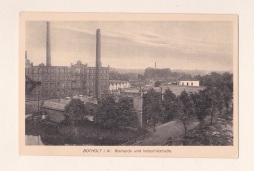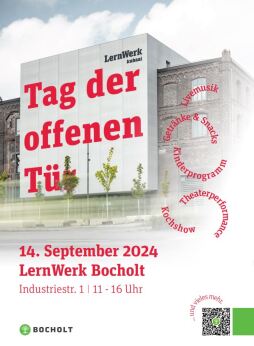City history: Herding in the past - LernWerk today
City archive presents the historical "photo of the month" September
To mark the occasion, the Bocholt city archive is looking at the construction history of today's LernWerk as part of its monthly series of topics. Initial plans for the construction of a factory building at the address Industriestraße 1 date back to 1888.
On 6 September of that year, Bocholter Faerberei & Druckerei Diepenbrock & Co. appliedfor a"building permit" for an extended single-storey weaving hall with a typical shed roof. However, the planned building between the Aa-Strang, the existing Diepenbrock factory site, Industriestraße and the Winterswijk-Bocholt railway line never materialised.
In 1892, the Diepenbrock company in question was transferred to the Aktiengesellschaft für Baumwoll-Industrie, which pushed ahead with this plan again from 1897 in a modified form as the so-called Hochbau. As an extension to the existing " warehouse buildingwith comptoir [office]", the new spinning mill building was to extend over four floors. The basement was to house the preparation area as well as the yarn and dust cellar. 36 carding machines were to be installed on the undivided ground floor and 14 spinning machines, so-called selfactors, on each of the two hall-like upper floors. With the reservation of a few conditions in the areas of fire and occupational safety as well as work hygiene, such as additional gender-separated "sorting" as well as washing and changing rooms including several "douche baths", approval was granted by the municipal building commission on 14 July 1897. Construction work began a month later, culminating in the acceptance of the shell by the building authorities in May 1898. From August onwards, the 45 metre high factory chimney was built, which, together with the new representative spinning mill building, went into operation in December 1898 with 33 male, 20 female and six juvenile workers. As an impressive example of the industrial architecture of the time, the building would go on to characterise the station area, as illustrated by the postcard from around 1910.
After many further extensions and conversions as well as a railway connection in 1905, financial bottlenecks led to the site being rented out to various companies during the First World War. In 1934, the Aktiengesellschaft für Baumwollindustrie finally went bankrupt. In the same year, Carl Herding acquired the site, under whose name it is still known today. After extensive renovation work, the city of Bocholt's new cultural centre, the LernWerk, opened its doors in this industrial monument in 2024.
Open day on Saturday, 14 September
Following extensive renovation work, the former Herding spinning mill has been transformed into a centre for the city's educational and cultural activities under the name "LernWerk". On Saturday, 14 September, the LernWerk will open its doors to the public from 11 am to 4 pm. Visitors can tour the building and enjoy snacks and drinks, live music, a children's programme, theatre performances and a cooking show.




